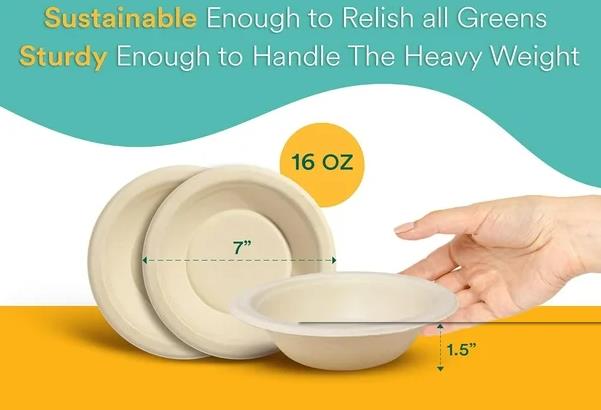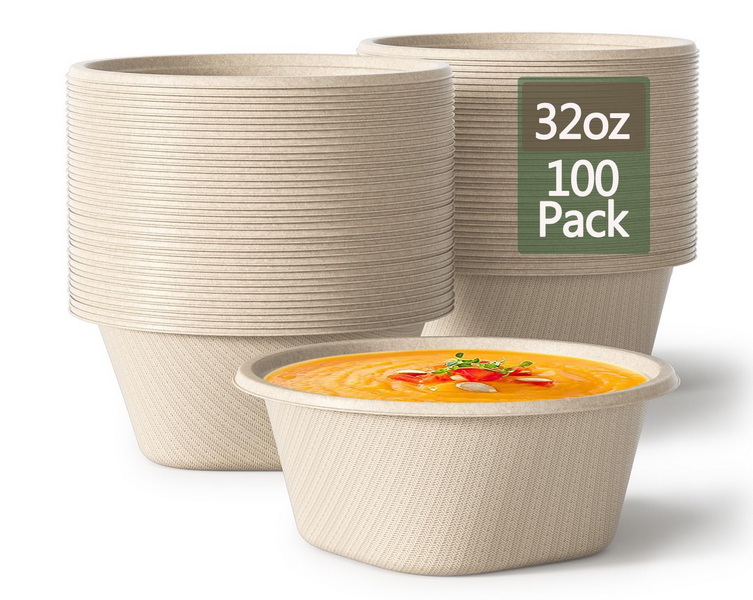
Content Menu
● The Growing Concern for Sustainability
● What are Ecofriendly Biobased Disposable Bowls?
● Advantages of Using Ecofriendly Biobased Disposable Bowls
● Materials Used in Ecofriendly Biobased Disposable Bowls
● Environmental Impact of Ecofriendly Biobased Disposable Bowls
● Challenges and Considerations
● The Future of Ecofriendly Biobased Disposable Bowls
● Conclusion
● FAQ
>> 1. What exactly are ecofriendly biobased disposable bowls?
>> 2. Are ecofriendly biobased disposable bowls more expensive than plastic bowls?
>> 3. How do I properly dispose of ecofriendly biobased disposable bowls?
>> 4. Are all ecofriendly biobased disposable bowls heat resistant?
>> 5. Can ecofriendly biobased disposable bowls improve my business's image?
The foodservice industry is experiencing a significant shift towards sustainability, driven by increasing environmental awareness and consumer demand for eco-friendly options. Among the various sustainable solutions, ecofriendly biobased disposable bowls have emerged as a popular choice. This article explores the reasons behind the popularity of these bowls, their benefits, the materials they are made from, and their impact on the environment and the foodservice industry.

The Growing Concern for Sustainability
The rise in popularity of ecofriendly biobased disposable bowls is closely linked to the growing global concern for sustainability. Traditional disposable bowls made from plastic and polystyrene have contributed significantly to environmental pollution. These materials are non-biodegradable and can persist in the environment for hundreds of years, leading to soil and water contamination, harming wildlife, and disrupting ecosystems.
Consumers and businesses alike are becoming more aware of these issues and are actively seeking alternatives that reduce their environmental footprint. This shift in mindset has created a demand for sustainable products, including ecofriendly biobased disposable bowls, which offer a viable solution to the environmental problems associated with traditional disposables.
What are Ecofriendly Biobased Disposable Bowls?
Ecofriendly biobased disposable bowls are single-use food containers made from sustainable materials that have a minimal environmental impact throughout their lifecycle. These bowls are designed to be an alternative to traditional plastic or Styrofoam bowls, addressing the environmental concerns associated with those materials.
The term "biobased" indicates that the materials are derived from renewable biological sources, such as plants. This contrasts with traditional plastics, which are typically made from petroleum, a non-renewable fossil fuel.
Advantages of Using Ecofriendly Biobased Disposable Bowls
Switching to ecofriendly biobased disposable bowls offers numerous advantages for both the environment and the foodservice industry.
- Reduced Carbon Footprint: The production and disposal of ecofriendly biobased disposable bowls generally have a smaller carbon footprint compared to traditional plastic bowls. Biobased materials often require less energy to produce, and their biodegradability means they break down naturally, reducing landfill waste and greenhouse gas emissions.
- Biodegradability and Compostability: A key feature of ecofriendly biobased disposable bowls is their ability to biodegrade and compost. Unlike plastic, which can take centuries to decompose, these bowls break down into natural elements in a relatively short period, especially under composting conditions.
- Use of Renewable Resources: Ecofriendly biobased disposable bowls are made from renewable resources such as sugarcane, bamboo, and palm leaves. These materials can be replenished naturally, making them a more sustainable choice compared to finite resources like petroleum.
- Non-Toxic and Food-Safe: These bowls are typically free from harmful chemicals and toxins commonly found in plastic. This ensures the safety of the food stored in them and provides peace of mind for consumers.
- Versatility: Ecofriendly biobased disposable bowls are suitable for a wide range of food items, from salads and soups to desserts and snacks. Their versatility reduces the need for multiple types of packaging, streamlining inventory management and reducing waste.
- Positive Brand Image: Using ecofriendly biobased disposable bowls can enhance a foodservice business's brand image. Consumers are increasingly likely to support businesses that demonstrate a commitment to sustainability, making it a valuable marketing advantage.
- Waste Reduction: By choosing ecofriendly biobased disposable bowls, the foodservice industry can significantly reduce the amount of plastic waste generated. This helps to alleviate the strain on landfills and minimize the environmental impact of disposable food containers.

Materials Used in Ecofriendly Biobased Disposable Bowls
Several materials are used to manufacture ecofriendly biobased disposable bowls, each with its unique properties and benefits.
- Sugarcane (Bagasse): Sugarcane bowls are made from bagasse, the fibrous residue left after extracting juice from sugarcane. This material is a byproduct of sugar production, making it a highly renewable and readily available resource. Sugarcane bowls are sturdy, heat-resistant, and compostable.
Sugarcane Bowl A sugarcane bowl showcasing its natural texture and durability.
- Bamboo: Bamboo is another popular material for ecofriendly biobased disposable bowls. It is one of the fastest-growing plants on Earth, making it a highly sustainable resource. Bamboo bowls are lightweight, strong, and naturally antimicrobial. They also have a visually appealing aesthetic, adding a touch of elegance to food presentation.
Bamboo Bowl A bamboo bowl displaying its sleek design and natural grain.
- Palm Leaf: Palm leaf bowls are made from fallen leaves of palm trees, which are collected, cleaned, and molded into various shapes. These bowls have a unique, rustic appearance and are fully biodegradable and compostable. They are also heat-resistant and can be used for both hot and cold foods.
Palm Leaf Bowl A palm leaf bowl exhibiting its natural patterns and earthy tones.
- Cornstarch (PLA): Polylactic acid (PLA) is a bioplastic derived from cornstarch. PLA bowls are lightweight, compostable, and can be used for cold and warm foods. However, they are not as heat-resistant as sugarcane or bamboo bowls and are best suited for temperatures below 110°F (43°C). They require specific composting conditions to break down effectively.
Cornstarch Bowl A PLA bowl demonstrating its smooth surface and lightweight design.
- Wheat Straw: Wheat straw is another agricultural byproduct that can be used to create disposable bowls. These bowls are sturdy, microwave-safe, and compostable.
Wheat Straw Bowl A wheat straw bowl showing its natural texture and robust construction.
Environmental Impact of Ecofriendly Biobased Disposable Bowls
The environmental impact of ecofriendly biobased disposable bowls is significantly lower than that of traditional plastic bowls. Here's a breakdown:
- Reduced Landfill Waste: Biobased bowls are biodegradable and compostable, which means they break down naturally in the environment, reducing the amount of waste sent to landfills. This helps conserve valuable landfill space and reduces the risk of soil and water contamination.
- Lower Greenhouse Gas Emissions: The production of biobased materials often results in lower greenhouse gas emissions compared to the production of plastic. Additionally, the decomposition of biobased bowls in compost facilities releases fewer harmful gases than the incineration of plastic waste.
- Sustainable Resource Management: The use of renewable resources like sugarcane, bamboo, and palm leaves promotes sustainable resource management. These materials can be replenished naturally, reducing the reliance on finite fossil fuels.
Composting Process An illustration of the composting process, highlighting how biobased materials break down into natural elements.
- Reduced Pollution: Ecofriendly biobased disposable bowls do not contribute to plastic pollution in oceans and waterways. Unlike plastic, which can persist in the environment for hundreds of years, these bowls break down into natural elements, minimizing their impact on marine life and ecosystems.
Challenges and Considerations
While ecofriendly biobased disposable bowls offer numerous benefits, there are also some challenges and considerations to keep in mind.
- Cost: Ecofriendly biobased disposable bowls can sometimes be more expensive than traditional plastic bowls. However, as demand for sustainable products increases, the cost is becoming more competitive.
- Composting Infrastructure: The effectiveness of biobased bowls in reducing waste depends on the availability of adequate composting infrastructure. If these bowls end up in landfills instead of compost facilities, they may not break down as quickly, negating some of their environmental benefits.
- Consumer Education: It is important to educate consumers about the proper disposal of ecofriendly biobased disposable bowls. Many consumers may not be aware that these bowls need to be composted in order to break down effectively.
- Durability and Performance: While ecofriendly biobased disposable bowls are generally durable, they may not be as resistant to heat or moisture as some types of plastic bowls. It is important to choose the right type of biobased bowl for the intended application.
The Future of Ecofriendly Biobased Disposable Bowls
The future of ecofriendly biobased disposable bowls looks promising. As technology advances and demand for sustainable products continues to grow, we can expect to see even more innovative and cost-effective biobased materials emerge. Furthermore, increased awareness and government regulations promoting the use of sustainable packaging will likely drive further adoption of ecofriendly biobased disposable bowls in the foodservice industry.
Conclusion
The popularity of ecofriendly biobased disposable bowls in the foodservice industry is driven by the growing concern for sustainability and the numerous environmental and business benefits they offer. By reducing carbon footprint, minimizing waste, and promoting the use of renewable resources, these bowls provide a viable alternative to traditional plastic disposables. While challenges such as cost and composting infrastructure remain, the future of ecofriendly biobased disposable bowls looks bright, with continued innovation and increased adoption expected in the years to come. Embracing these sustainable solutions is not only good for the planet but also enhances brand image and meets the evolving expectations of environmentally conscious consumers.

FAQ
1. What exactly are ecofriendly biobased disposable bowls?
Answer: Ecofriendly biobased disposable bowls are single-use food containers made from renewable biological sources, such as plants. They are designed to be an alternative to traditional plastic or Styrofoam bowls, addressing the environmental concerns associated with those materials. These bowls are typically biodegradable and compostable.
2. Are ecofriendly biobased disposable bowls more expensive than plastic bowls?
Answer: Initially, ecofriendly biobased disposable bowls might be more expensive than traditional plastic bowls. However, as demand increases and production processes become more efficient, the cost difference is narrowing. The long-term environmental and social benefits often outweigh the slightly higher upfront cost.
3. How do I properly dispose of ecofriendly biobased disposable bowls?
Answer: The ideal way to dispose of ecofriendly biobased disposable bowls is through composting. Check if your local municipality has composting facilities or programs. If composting is not available, some bowls are still biodegradable and will break down in landfills, although at a slower rate than in a compost environment. Always check the specific product's instructions for the best disposal method.
4. Are all ecofriendly biobased disposable bowls heat resistant?
Answer: Not all ecofriendly biobased disposable bowls have the same heat resistance. Bowls made from sugarcane (bagasse) and palm leaf tend to be more heat-resistant than those made from cornstarch (PLA). Always check the manufacturer's specifications to ensure the bowl is suitable for the intended use, especially for hot foods.
5. Can ecofriendly biobased disposable bowls improve my business's image?
Answer: Yes, using ecofriendly biobased disposable bowls can significantly improve your business's image. Consumers are increasingly aware of environmental issues and are more likely to support businesses that demonstrate a commitment to sustainability. Using ecofriendly products can enhance your brand reputation and attract environmentally conscious customers.

















